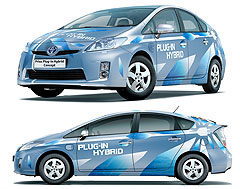Toyota’s plug-in Prius set for real-world trials
BY TERRY MARTIN | 11th Sep 2009

Confirming that the Prius Plug-in Hybrid is much more than a mere concept, Toyota has announced that around 500 cars will be leased to customers worldwide for real-world evaluation of performance and for monitoring driver attitudes and experiences with the model, which cuts CO2 emissions to less than 60g/km and offers an extended full-electric driving range of 20km up to 100km/h.
Featuring lithium-ion batteries rather than nickel-metal hydride used in the regular Prius, the plug-in Prius’ EV mode improvements are streets ahead of the current model, which can be driven on electric-only power at speeds of up to 50km/h for just 2km, depending on the driving style.
The emissions reduction is also much greater than the current model’s 89g/km – a figure that already allows Toyota Australia to claim the Prius III is the cleanest production car sold in this country.

The plug-in version uses the Prius III’s upgraded Hybrid Synergy Drive system, which includes a 73kW/142Nm 1.8-litre engine and combines this with a 60kW/207Nm electric motor. The system drives the front wheels through a CVT.
The key ingredient to the improved performance is the high-output lithium-ion batteries – the first time this technology has appeared in a hybrid vehicle from Toyota.
While it can run as an electric vehicle in urban areas for longer distances and at higher speeds than the conventional Prius, the plug-in version will automatically revert to conventional petrol power over extended journeys or when the limit of battery power is reached.
According to Toyota, the lithium-ion battery technology allows for full recharging in 1.5 hours using a 230-volt outlet.
While Toyota has long been an advocate of nickel-metal hydride batteries, describing them as “proven and reliable” at the recent launch of the Prius III in Australia, the Japanese manufacturer concedes that lithium-ion is much better suited for plug-in applications, allowing for quick recharging, higher performance and compact packaging.
“The environmental benefits of electric cars for urban commuting are well documented, but vehicle development has been hampered by the drawbacks of the weight, size and cost of the large-capacity batteries needed to provide even a modest driving range, and the lack of an adequate recharging infrastructure,” the company said.
“Progress in battery technology makes plug-in hybrid architecture the most workable solution for an electrified powertrain. The system overcomes the issue of a limited cruising range by enabling an automatic switch to a traditional full hybrid petrol-electric system once the vehicle reaches the limit of its EV driving range.
“The new battery is more compact and has a higher volumetric energy density, so it does not compromise vehicle weight and packaging. Perhaps more importantly, it can be recharged much more quickly than the nickel-metal hydride type.” As in the conventional Prius, the plug-in model’s air-conditioning can be activated remotely – and in this case, when the vehicle is plugged in – which enables the cabin to be brought to the desired temperature before setting off. This in turn maximises the available range in EV mode.
The plug-in model is also equipped with a Hybrid System Indicator, which includes information on the EV range, based on the level of battery charge. An engine starting point display has also been added to emphasise the increase in the EV range.
Citing its own research into commuting patterns, Toyota claims that more than 80 per cent of car journeys in the UK and France cover a distance of less than 25km, while the UK, 80 per cent are less than 10km long.
“These figures confirm the potential for electricity in providing short- to mid-term sustainable mobility,” the company said.